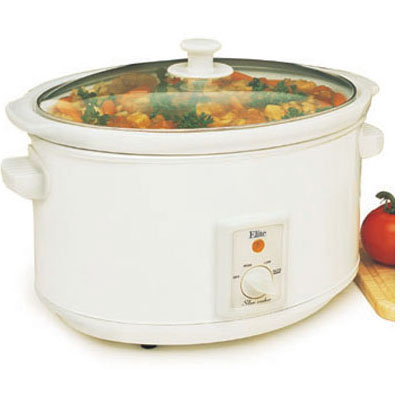My mother-in-law bought us a slow-cooker (also known as a crock pot in some parts of the world) in about 2004. We had just moved out of a basement apartment, bought our first house and Dani’s mom couldn’t believe that we didn’t have the quintessential family cooking tool. So she hit up Wal-Mart and got us one.
I’m not a slow cooker connoisseur or meal making expert but I’ve used it a couple of dozen times for  pork, roast beef an chili. Definitely more of a winter appliance for us. My twitter friend, Charlotte Observer food writer Kathleen Purvis called me a couple of weeks ago with a reader question about the safety of cooking foods in a slow-cooker. She wanted to know if I had heard of any changes in slow-cooker guidelines or any new food safety concerns with the tool.
pork, roast beef an chili. Definitely more of a winter appliance for us. My twitter friend, Charlotte Observer food writer Kathleen Purvis called me a couple of weeks ago with a reader question about the safety of cooking foods in a slow-cooker. She wanted to know if I had heard of any changes in slow-cooker guidelines or any new food safety concerns with the tool.
I hadn’t. There are lots of food myths and memes out there.
I often get questions about the safety of using slow-cookers, the concern being that they work using a slow cook/low heat process. Low temperature in this case is a relative term. According to USDA (and verified by my small sample size of one) once they heat food up, slow-cookers keep moist foods at between 170F and 280F. Well above the temps that bacteria need to grow. This is low compared to oven baking, grilling or frying, but it’s essentially braising the food (if it’s a meat) or stewing it.
Q: I scorched some slow cooker recipes and called Rival about my 2-year-old slow cooker. I was told the Food and Drug Administration now requires all cookers to be a minimum of 250 degrees, which means there is no "low" setting, and that 10- to 12-hour recipes should be 5 to 6 hours instead.
A: Jarden Consumer Solutions, which owns the Rival Crock-Pot brand, says there has been no change in the temperature of slow cookers or the recommended cooking times in recipes. The cookers are made with both a high and low setting, but the difference between them is how quickly the temperature increases.
Benjamin Chapman, the food safety specialist with N.C. State University, also had no information that the FDA’s recommendations have changed.
"The way a slow cooker works, it’s a safe process," he says. A slow cooker braises food, using a small amount of liquid in a closed environment to cook slowly with moisture, allowing meat fibers to break down and concentrating flavors.
You do need to make sure that there is some moisture in the cooker, however. The only way to scorch food would be if there were no liquid with the food in the cooker.
"Because there’s liquid and steam, there’s direct heat that cooks relatively evenly," said Chapman. "That steam, as it rises, condenses and keeps the moisture in and that helps to regulate temperature."
